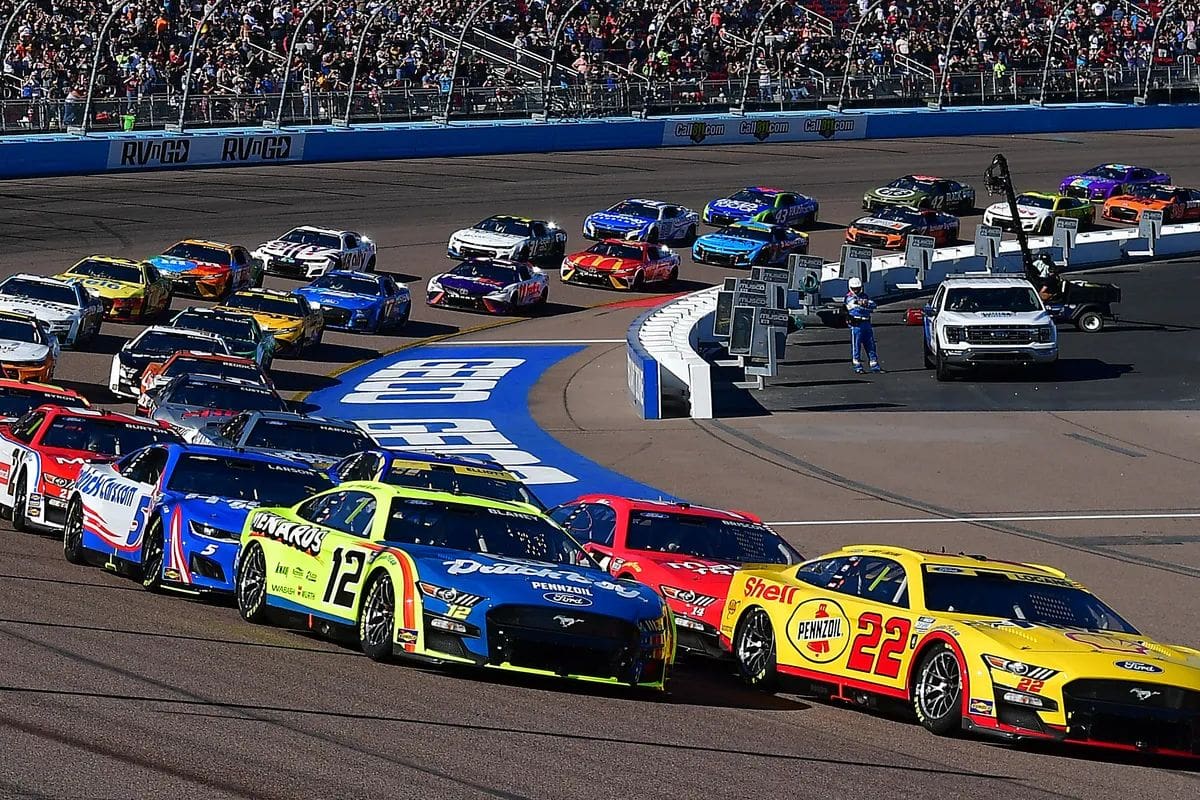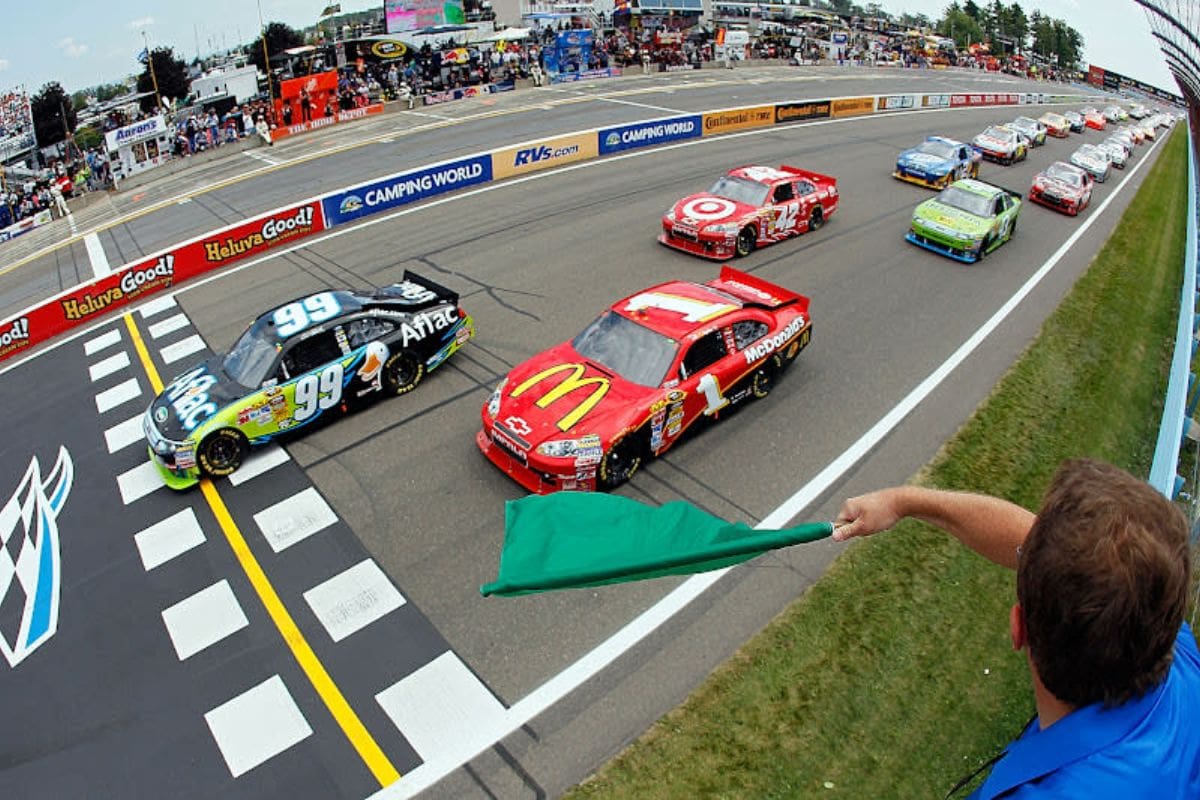Denny Hamlin’s Costly Mistake in Atlanta: Denny Hamlin‘s decision to adopt a conservative strategy during the Atlanta race has sparked notable debate regarding his approach under stress, resulting in a disappointing P24 finish. This is invites criticism from fellow drivers and his crew chief and raises questions about his mental fortitude as he heads into Watkins Glen. Given his impressive track record at this venue, the stakes are high. Will Hamlin’s experience and adaptability allow him to reclaim his competitive edge, or will the shadow of Atlanta loom larger than anticipated? The upcoming race holds crucial implications for his championship aspirations.
Key Highlights
- Denny Hamlin’s conservative strategy at Atlanta led to a missed opportunity for stage points and increased pressure for future races.
- His experience with nine top-10 finishes at Watkins Glen suggests he has the potential for a strong recovery.
- Qualifying will be crucial at Watkins Glen, where limited passing zones make starting position vital for race success.
- Tire management will play a significant role due to new tire dynamics and historical wear patterns at the track.
- Focused mental preparation and team communication may help Hamlin overcome previous setbacks and enhance performance.
Hamlin’s Underwhelming Performance at Atlanta
Denny Hamlin’s performance at the Atlanta Motor Speedway served as a clear reminder of the unpredictability that can plague even the most seasoned drivers in the NASCAR Cup Series. Despite entering the race with a solid season record, including three victories, Hamlin’s P24 finish was a noticeable contrast to his expectations. Known for his proficiency on superspeedways, he was anticipated to challenge for a top position, yet his defensive strategy failed to materialize effectively.
Criticism from notable figures such as Dale Earnhardt Jr. and Kevin Harvick highlighted the inadequacies of Hamlin’s approach. Their insights reflect the broader community’s expectations, which were not met during this significant event. Additionally, an acknowledgment of the strategy’s shortcomings from a member of Hamlin’s #11 team adds a layer of accountability that is often absent in competitive sports.
This admission signifies an understanding that even elite drivers must continuously adapt their tactics to the evolving dynamics of the race. As Hamlin prepares to shift his focus to the upcoming races, particularly the Watkins Glen event, the question remains will he recalibrate his strategies to improve his performance?
The disappointment in Atlanta could serve as a catalyst for reflection and enhancement. In the NASCAR Cup Series, the ability to learn from missteps is essential, and Hamlin’s resilience will be tested in the coming weeks. The path is not just about speed but also about strategy and adaptability.
Mistake in Strategy at the Quaker State 400
Strategizing for success is an essential component of competitive racing, yet Denny Hamlin’s approach during the Quaker State 400 proved to be a costly miscalculation. After grappling with a powertrain issue that relegated him to the back of the grid, Hamlin’s decision to adopt a defensive strategy was both unexpected and detrimental.
A driver of his caliber, known for his insight on tracks like Atlanta, was expected to seize the opportunity and fight for position aggressively. Instead, he wait for a potential wreck to create an opening, a choice that ultimately led to his disappointing P24 finish.
This conservative tactic not only deprived him of any stage points but also left him vulnerable to being involved in a wreck himself, which is precisely what transpired. The irony lies in Hamlin’s experience; with the stakes so high, his instinct to play it safe backfired spectacularly.
JOEY LOGANO WINS AS DENNY HAMLIN AND OTHERS CRASH BEHIND HIM AT ATLANTA MOTOR SPEEDWAY! pic.twitter.com/5D5UduJNGH
— FOX: NASCAR (@NASCARONFOX) September 8, 2024
The race was a vital opportunity to strengthen his playoff standing, yet he now finds himself precariously positioned—just two points above the elimination line.
Such a tactical error raises important questions about decision-making under stress. In the fiercely competitive landscape of NASCAR, hesitation can be just as damaging as miscalculation.
As Hamlin prepares for the next race at Watkins Glen, he must reflect on this episode and recalibrate his approach to guarantee future success. Mastery in racing is not merely about speed; it also hinges on the ability to adapt and seize the moment.
Criticism from Fellow Drivers and Crew Chief
The backlash against Denny Hamlin’s cautious racing strategy in Atlanta was palpable among his peers and crew, revealing a broader discourse on the expectations placed upon elite drivers. For a competitor of Hamlin’s caliber, the decision to adopt a conservative approach during a critical race not only puzzled fans but also drew sharp criticism from fellow drivers and his crew chief.
Dale Earnhardt Jr. a long-time friend and veteran of the sport, expressed his surprise at Hamlin’s demeanor, stating, “It’s just out of character.” This sentiment resonated with Kevin Harvick, who labeled the strategy a “complete failure,” emphasizing that Hamlin’s strength lies in aggressive driving, particularly on superspeedways. Harvick’s assertion that “you cannot race this car scared” highlighted a shared expectation among elite drivers to seize opportunities aggressively.
“If I am a Denny Hamlin fan and if I want look Denny’s probably come out of this okay, he’s probably gonna make it to the next round. This all gets forgotten. He’s just out of character. I don’t know how else to say it. I was a little surprised by that approach from him.”-(dale jr.)
“Whatever it was, it’s a complete failure. And when you look at the 11 strategies, it goes totally against everything that they are. Denny Hamlin is great on the superspeedway. They got no stage points, crashed at the end, and now they’re, you know, two points above the cut line. So you cannot race this car scared.”-(Kevin Harvick)
No. 11 Crew Chief Chris Gabehart (@CG1751) explains his teams strategy @ATLMotorSpdwy on Sunday.
🗣️ "I didn't expect the rest (of the race) to be as conservative as it was on his behalf. And we didn't plan that together. I wish we would have."
More → https://t.co/MKhd9eLXG8 pic.twitter.com/3cJnGEnwEO
— SiriusXM NASCAR Radio (Ch. 90) (@SiriusXMNASCAR) September 12, 2024
“I didn’t expect the rest of it to be as conservative as it was on his behalf, and we didn’t plan that together. I wish we would have changed our, I wish we would have. Had I known that was more of an issue in his head, I would have done my best to talk through the scenario ahead of time with him.”-(gabehart)
Adding to the chorus of disapproval was Chris Gabehart, Hamlin’s crew chief, who acknowledged his own misjudgment in the situation. While he first supported a cautious start to avoid early race errors, he later admitted that he did not anticipate the extent of Hamlin’s restraint.
This collective criticism reveals not just disappointment but a profound understanding of the competitive nature of NASCAR. As Hamlin prepares for Watkins Glen, he must navigate not only the track but also the expectations of those who believe in his potential to rebound from this costly misstep.
Key Factors for Success at Watkins Glen
Although the recent disappointment at Atlanta weighs heavily on his mind, Hamlin’s focus now shifts toward mastering the unique challenges presented by Watkins Glen. Success at this road course requires a multifaceted approach, especially given Hamlin’s past struggles and recent improvements. His experience here offers a clear roadmap for what it takes to excel.
- Adaptability in Strategy: Hamlin recognized the importance of adjusting his racing strategy throughout the race. Quick thinking and real-time decision-making will be significant in traversing Watkins Glen’s complex layout.
- Cornering Precision: The track features tight turns and elevation changes, demanding exceptional cornering skills. Hamlin must prioritize braking points and throttle control to maintain speed without sacrificing position.
- Tire Management: Given the unique tire dynamics at Watkins Glen, understanding how to conserve tire life while maximizing grip will be fundamental. Hamlin’s past performances suggest that maintaining tire health can lead to stronger finishes.
- Mental Resilience: After a setback, mental fortitude is indispensable. Hamlin must stay focused, overcoming any lingering frustration from Atlanta, to perform at his best in this high-pressure environment.
With nine top-10 finishes and only two races outside the top five since 2016, Hamlin’s experience positions him favorably. By honing in on these key factors, he can capitalize on his knowledge and racecraft to reclaim his competitive edge at Watkins Glen.
Importance of Qualifying and New Tire Dynamics at Watkins Glen
Mastering Watkins Glen requires not only skillful driving but also a keen understanding of the track‘s subtleties, particularly the importance of qualifying. Denny Hamlin, a seasoned competitor, emphasizes this notion by highlighting that qualifying is essential due to the unique characteristics of the track. With its limited passing zones and heavy reliance on aerodynamics, the ability to secure a front-row starting position can dramatically influence the race outcome.
The introduction of new tires adds another layer of complexity to the qualifying process. Hamlin pointed out that if the tires wear as quickly as anticipated, drivers may find themselves with only one shot to set a competitive lap time.
“It’s one of my favorite road courses. It’s got a handful of passing zones. Qualifying is really, really important there. I can’t emphasize how important qualifying is, because the speeds that we run, aerodynamics meaning so much, and really the one-lane track that it is, it’s just, you gotta qualify well. That’s going to be the key.”-(hamlin)
Unlike previous tire dynamics that allowed for lap time improvement over multiple runs, this new tire formula is expected to behave differently, potentially leading to slower times if a subsequent attempt is needed. Such dynamics intensify the stress on drivers to deliver a flawless performance during qualifying.
“This will be the X-Factor, with this new tire, if it does wear as quick as they’re talking about, you’re going to have one shot at it. Because if you have to go and re-run again, the lap time will likely is just going to be just so far off. I remember last year, the more times that you ran in on the tires, the more cycles you put on it. It just kept getting faster. But this one doesn’t sound like it’s going to be like that.”-(hamlin)
As teams prepare for the upcoming race, strategizing around these tire dynamics will be significant. The interplay between qualifying success and tire management will likely dictate not only individual performances but also broader implications for championship aspirations.
For Hamlin, mastering these elements could be vital in overcoming his recent setbacks and fortifying his title hopes. Observers will be keen to see if he can utilize his understanding of the track and tire conditions to reclaim his competitive edge this weekend.
News in Brief: Denny Hamlin’s Costly Mistake in Atlanta
Denny Hamlin’s tactical miscalculation at the Atlanta race highlights the complexities of decision-making under competitive strain. The subsequent scrutiny emphasizes the necessity for adaptive strategies and mental resilience in high-stakes scenarios. As the series shifts to Watkins Glen, the importance of qualifying and effective tire management becomes paramount. Success in this upcoming race could restore confidence and momentum, Hamlin’s ability to navigate challenges and ultimately contend for the championship.
ALSO READ: Denny Hamlin Blames His Dog for Recent Struggles: Can He Shake Off the Slump?





